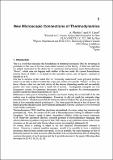Por favor, use este identificador para citar o enlazar a este item:
http://hdl.handle.net/10261/46146COMPARTIR / EXPORTAR:
 SHARE
BASE SHARE
BASE
|
|
| Visualizar otros formatos: MARC | Dublin Core | RDF | ORE | MODS | METS | DIDL | DATACITE | |

| Título: | New Microscopic Connections of Thermodynamics |
Autor: | Plastino, A.; Casas, Montserrat CSIC | Fecha de publicación: | ene-2011 | Editor: | InTech | Citación: | Thermodynamics 1-20 (2011) | Resumen: | This is a work that discusses the foundations of statistical mechanics (SM) by revisiting its postulates in the case of the two main extant versions of the theory. A third one will here we added, motivated by the desire for an axiomatics that possesses some thermodynamic “flavor”, which does not happen with neither of the two main SM current formulations, namely, those of Gibbs’ (1; 2), based on the ensemble notion, and of Jaynes’, centered on MaxEnt (3; 4; 5). One has to mention at the outset that we “rationally understand” some physical problem when we are able to place it within the scope and context of a specific “Theory”. In turn, we have a theory when we can both derive all the known interesting results and successfully predict new ones starting from a small set of axioms. Paradigmatic examples are von Neumann’s axioms for Quantum Mechanics, Maxwell’s equations for electromagnetism, Euclid’s axioms for classical geometry, etc. (1; 3). Boltzmann’s main goal in inventing statistical mechanics during the second half of the XIX century was to explain thermodynamics. However, he did not reach the axiomatic stage described above. The first successful SM theory was that of Gibbs (1902) (2), formulated on the basis of four ensemble-related postulates (1). The other great SM theory is that of Jaynes’ (4), based upon the MaxEnt axiom (derived from Information Theory): ignorance is to be extremized (with suitable constraints). Thermodynamics (TMD) itself has also been axiomatized, of course, using four macroscopic postulates (6). Now, the axioms of SM and of thermodynamics belong to different worlds altogether. The former speak of either “ensembles” (Gibbs), which are mental constructs, or of “observers’ ignorance” (Jaynes), concepts germane to thermodynamics’ language, that refers to laboratory-parlance. In point of fact, TMD enjoys a very particular status in the whole of science, as the one and only theory whose axioms are empirical statements (1). Of course, there is nothing to object to the two standard SM-axiomatics referred to above. However, a natural question emerges: would it be possible to have a statistical mechanics derived from axioms that speak, as far as possible, the same language as that of thermodynamics? To what an extent is this feasible? It is our intention here that of attempting a serious discussion of such an issue and try to provide answers to the query, following ideas developed in (7; 8; 9; 10; 11; 12; 13). | Versión del editor: | http://www.intechopen.com/articles/show/title/new-microscopic-connections-of-thermodynamics | URI: | http://hdl.handle.net/10261/46146 | ISBN: | 978-953-307-544-0 |
| Aparece en las colecciones: | (IFISC) Libros y partes de libros |
Ficheros en este ítem:
| Fichero | Descripción | Tamaño | Formato | |
|---|---|---|---|---|
| InTech-New_microscopic_connections_of_thermodynamics.pdf | 163,51 kB | Adobe PDF |  Visualizar/Abrir |
CORE Recommender
Page view(s)
271
checked on 04-may-2024
Download(s)
215
checked on 04-may-2024
Google ScholarTM
Check
Altmetric
NOTA: Los ítems de Digital.CSIC están protegidos por copyright, con todos los derechos reservados, a menos que se indique lo contrario.
